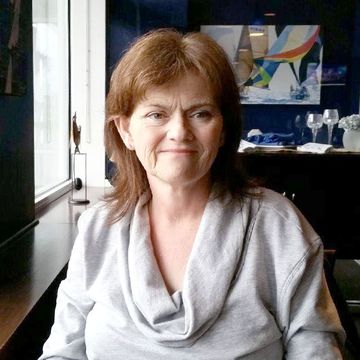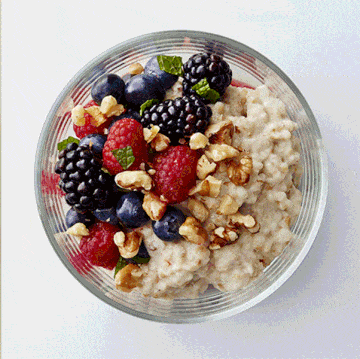Kaela G. recalls the Saturday in spring that changed her life. The then-19-year-old college freshman was back in her childhood home for Easter weekend after surviving the extra-stressful days of midterm exams.
"I remember lying in my own bed thinking, 'Thank goodness this week is over,' and then letting out a big sigh of relief, like, 'I made it!'" she says.
She woke up around 7 the next morning and noticed her left arm was numb. Assuming she had slept on it in an awkward position, Kaela ignored it, ate breakfast, and hopped in the shower to get ready for work at her mother's business, a local spa. With her arm still "asleep," she dropped her hairbrush while blow-drying her hair.
"I didn't think anything of that, either."
The spa was taking care of a wedding party that day, "which was my favorite day to be there because it's so much fun with high energy," Kaela says. But not this time. When she couldn't stop yawning, Kaela poured herself a half-cup of coffee and stood with her drink at the front of the salon.
Then everything went black.
"It literally felt like my face hit the ground or I ran into a brick wall," she remembers. "I opened my eyes expecting to find myself lying on the floor, but I was still standing. And that's when I knew something was wrong."
Kaela dialed up her mother, who wasn't at the spa yet. She thought Kaela had low blood sugar and suggested eating a banana and drinking some orange juice. But as Kaela walked to the break room, she realized her body wasn't functioning properly.
"I had to lean in to the wall on my right side and drag my left leg behind me the whole way," Kaela says. "By the time I made it to the room, I was exhausted and out of breath."
Within minutes, her mother arrived at the spa and drove Kaela to the emergency room.
"I was saying, 'Mom, pinch my arm — I can't feel it!'" Kaela remembers. "The best way I could describe it was if my blood was jumping on a trampoline — that's what it felt like inside of me. My mother was driving faster and faster and I could tell she was getting more worried."
The Numbing Diagnosis
After being examined right away at the hospital, Kaela spent the next seven hours going through a battery of exams, including blood tests, a CAT scan, and an MRI. Around 7 p.m., a doctor walked into her room.
"He came in very somber and said, 'Kaela, you had a stroke,'" she remembers. "It was like slow motion for a few minutes until my mom and I just broke down crying."
It didn't make any sense — she was a healthy, athletic college student who had been dancing since she was 3 years old. She'd had no signs of trouble before that Saturday.
Within minutes of her diagnosis, a team of doctors and nurses swarmed her bed to prevent another stroke from happening. And that's when things got confusing: It was unclear why she'd had a stroke in the first place. Many months later, doctors discovered that Kaela had a tiny hole in her heart, but concluded it wasn't the cause of her stroke. In fact, they couldn't find any clear cause of her stroke.
The "Uncertain" Stroke
When people talk about strokes, it's usually one of two main types: ischemic stroke, which is caused by a blood clot blocking the flow of blood to the brain, or hemorrhagic stroke, which is caused by a blood vessel rupturing and preventing blood flow to the brain.
But there's another type – Kaela's type – that people rarely talk about: cryptogenic stroke.
"About one in three ischemic strokes are labeled as a cryptogenic stroke, meaning that the cause of the stroke has not been determined, even after extensive testing," explains Mitchell Elkind, MD, chair of the American Stroke Association Advisory Committee and professor of neurology and epidemiology at Columbia University. "About 200,000 people are affected by this type of stroke each year."
Because the root cause of cryptogenic stroke is unclear, it makes preventing a recurrent stroke especially difficult, Dr. Elkind says. In these cases, doctors "explore advanced diagnostic testing to identify causes that may be missed through a traditional workup, like AFib (a.k.a. atrial fibrillation, or an irregular heartbeat), heart structure problems, or blood clotting disorders."
It's vital that a cryptogenic stroke patient work with a healthcare team – which usually includes neurologists, neurosurgeons, cardiologists, primary care providers, nurses, and therapists — that can treat known risk factors, explore underlying risk factors, as well as coordinate treatment.
"We know that about 90% of strokes are caused by 10 risk factors, about 80% of which are preventable," Elkind says. "The key to stroke prevention is managing these factors, which include high blood pressure (more than half of all strokes are caused by uncontrolled hypertension) cigarette smoking, atrial fibrillation, and physical inactivity."
The Stressful Recovery
After her stroke, Kaela was prescribed blood thinners and a medication to essentially "block" the hole in her heart. But she lived in constant fear of suffering another stroke.
"Every single night for many years, I'd wake up and dig my nails into my arm to make sure I could feel it through the pins and needles," she says.
She also worked with a personal trainer to strengthen the left side of her body and improved her eating habits by following a plant-based diet.
"It's a low-sodium diet and I'm very conscious of sugars," she says. "I learned to focus on keeping my blood pressure low and my blood sugars low to prevent having another stroke."
But a couple years later, at age 22, Kaela was in the hospital again with scarily similar symptoms. The doctors said she had a mini-stroke; however, when Kaela met with specialists at the Mayo Clinic earlier this year, they concluded that it wasn't a second stroke and was instead her body's way of reacting to stress by "recreating" her first stroke.
Kaela, now 26, wants others to learn from her experience. "Living a healthy lifestyle is so important, and that includes stress management because that was one component I never considered," she says. "At the end of each day, I ask myself, 'Is whatever is stressing me out worth having a stroke over?' And it never is."
It's still a mystery why she had a stroke at 19. But after receiving "the Cadillac of tests" at the Mayo Clinic, she's decided to stop trying to figure out what caused her condition … for now.
"But if there's new research that I hear of, I will absolutely be back and ask them if they could test me," she says.
To learn more about cryptogenic stroke and for additional resources, visit www.strokeassociation.org/cs.















